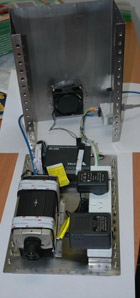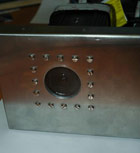Details About the Parkes Webcam
The Parkes webcam provides images of the telescope every minute or so, day and night. Once every hour these images are automatically compiled into a daily movie that can be downloaded from the web. The webcam is more sophisticated than those you commonly buy in a computer store. To learn more about the camera and the special constraints on its operation at a radio telescope please read on.
Webcam Details
The Parkes webcam is a Pixord 120 with a resolution of 704x576 pixels and a built-in webserver. It sits on a shelf in a hut next to the Parkes radio telescope. A program fetches a still image from the camera every minute or so for display and archiving. Once every hour another program stacks the images from the last 24 hours into the publicly available movies. Each morning a high-quality, full-resolution movie is automatically made, archived and available for download from the website.

The camera's lens has a focal length of 3.6 mm, and the field of view is 77° horizontally and 58° vertically. This slightly distorts the image so that the ground appears to curve up either side of the telescope but allows the full range of the telescope's motion to be visible.
Radio Frequency Interference (RFI)

The camera radiates at radio wavelengths, which would affect astronomical observations. This is known as Radio Frequency Interference (RFI). Radio telescopes such as Parkes use very sensitive radio receivers and powerful low noise amplifiers to receive and amplify the incredibly faint radio waves gathered from space. They are therefore susceptible to interference from closer, more powerful sources of radio waves such as TV transmitters, aircraft, mobile phones, microwave ovens, video cameras and even webcams. Before the webcam could be installed and operated a case was designed and tested so that it did not emit any radio interference.
The case is designed as a Faraday cage, a conducting box. The picture on the right shows the disassembled box, with the front and back covers removed. You can see the camera, a media converter (the flat black box at the rear) and the two power supplies. The media converter is the interface between the (copper) Ethernet connection of the camera and an optical fibre Ethernet connection.
Ethernet is a source of RFI which can interfere with observations by the telescope so has to be shielded. The mains plug is a special one that filters out high-frequency signals. Otherwise the power leads inside the box would pick up the RFI and radiate it away on the outside. Warm air is transported outwards with a fan to keep the camera from overheating.

Here is a close-up of the front panel of the box. Somehow we had to get the light into the box with out letting any radiation out. The solution was a piece of glass with a thin coating of Indium Tin Oxide (ITO) that is an electrical conductor. You may be surprised that so many screws were needed to fix the glass, but there is a simple reason for it. The separation of the screws is defined by the shortest wavelength which needs to be filtered. In the lab, we measured RFI at wavelengths of up to 20 cm, but to make it safe we assumed 15 cm as the shortest wavelength. Faraday cages are usually designed so that the largest mesh openings have a diameter of 1/10 of the shortest wavelength, so we adopted a separation of the screws of 1.5 cm. For the body we chose a separation of 3 cm, but there is an additional layer of copper between the two pieces to ensure that contact is established at least every 1.5 cm. In addition, the front and back covers are tightly sealed with conducting tape.
The plots below show the radio emissions produced by the camera when it is:
Every computer and other electrical device used near the Parkes radio telescope has to be checked for RFI. All the computers in the offices and Visitors Centre are also placed in purpose-built Faraday cages.


